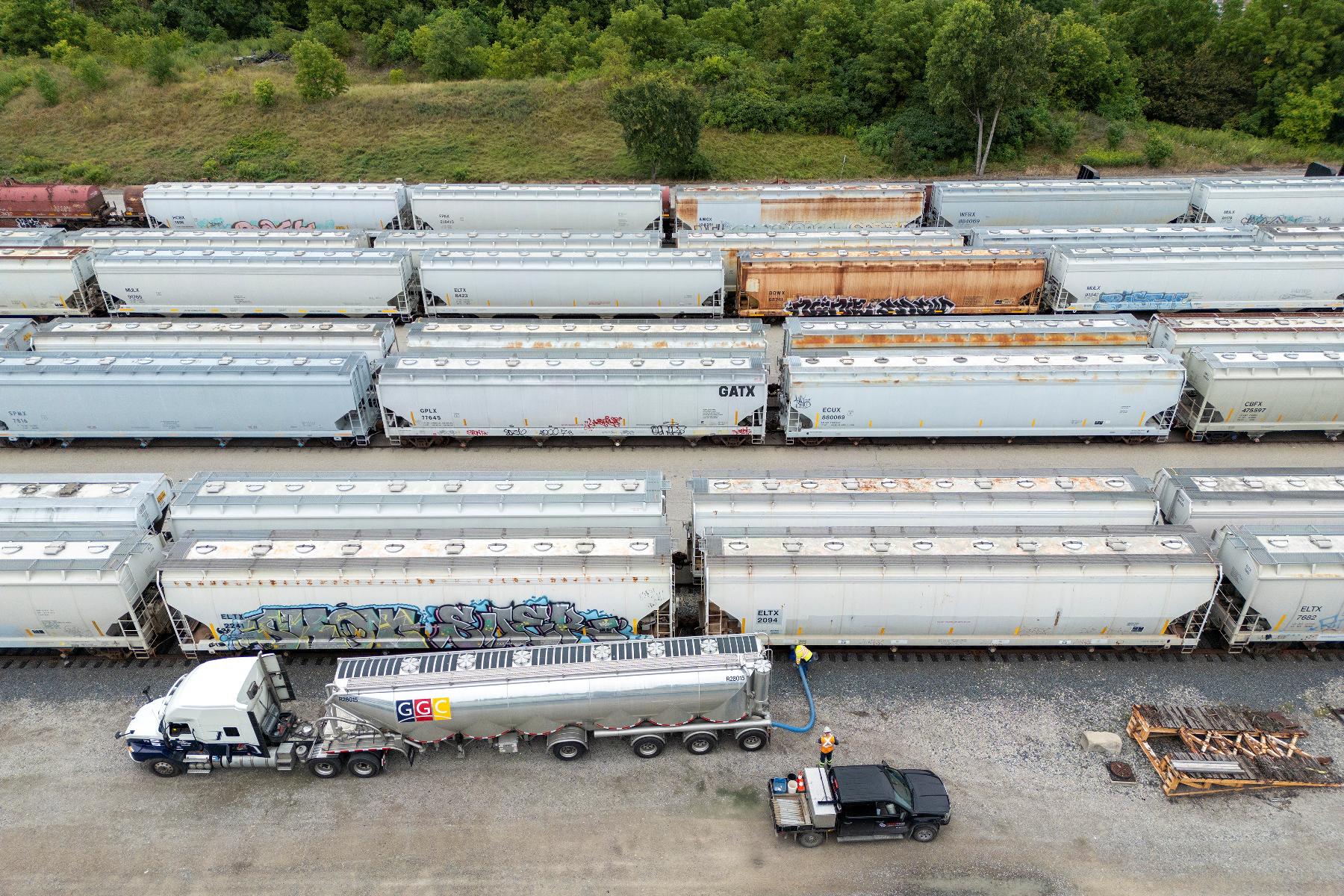
2024-08-20 16:06
BUENOS AIRES, Aug 20 (Reuters) - Argentina's economic activity likely fell in June versus the same month a year earlier, analysts said, back in the red after a rare rise the month before amid tough austerity measures and cost-cutting under libertarian President Javier Milei. The median forecast from 16 analysts sees economic activity down 1.9% year-on-year in the sixth month of the year, dropping back from May's 2.3% rise, as growth in the grains and gas sectors is weighed down by weak consumption and construction. The president's cost-cutting agenda has helped achieve rare fiscal surpluses and has allowed the central bank to rebuild reserves, but the economy has suffered, with consumption, construction and manufacturing down sharply. "The economies of major cities, centrally linked to consumption and the industrial and construction sectors, continues to show a strong downward trend," said Pablo Besmedrisnik, an economist at VDC consultancy. Meanwhile, agriculture is seen rebounding from a low base recorded a year ago and the oil and gas sector is seen growing due to a boost in shale production, Besmedrisnik added. Analysts forecasts ranged between a maximum drop of 3.2% and maximum growth of 2.0%. Juan Massot, research director at the Universidad del Salvador in Buenos Aires, said that the economy's decline was approaching its bottom, although this isn't consistent across all sectors. "While primary sectors like agriculture, mining, and hydrocarbons are growing, those sectors reliant on domestic consumption and the population's real income aren't faring as well," said Massot. Economists said they expect Argentina's recovery to be slow, as the government works to contain monetary expansion and prioritizes a restrictive fiscal policy in order to combat an inflation rate over 260% on an annual basis, which despite a recent slowdown remains the highest in the world. Argentina's statistics agency INDEC will publish its monthly economic activity estimate for June on Wednesday. Sign up here. https://www.reuters.com/markets/argentina-economic-activity-seen-back-red-june-2024-08-20/

2024-08-20 14:38
Panel to consider independent appraisal of Hess Guyana Exxon sees Chevron-Hess merger as disguised asset buy, say sources Hess Guyana makes up 70% of Chevron's $53 bln bid, say analysts Chevron, Hess see appraisal as irrelevant to arbitration case Aug 20 (Reuters) - An arbitration panel that will decide a high-profile clash between Exxon Mobil (XOM.N) , opens new tab and Chevron (CVX.N) , opens new tab will delve into the secret value of Hess' (HES.N) , opens new tab oil riches in Guyana, four people familiar with the matter said. Chevron (CVX.N) , opens new tab last October offered to pay $53 billion for Hess, one of the two biggest deals in the largest wave of consolidation in the oil industry in decades. The asset most coveted by Chevron in the takeover is Hess’s stake in a Guyana field operated by top U.S. rival Exxon. Exxon and China's CNOOC (0883.HK) , opens new tab, another partner in the venture, have challenged the deal, claiming a contractual first right to buy Hess’s stake in the field, a matter to be decided by a three-person arbitration panel. Getting the panel to consider the appraised value is central to Exxon's claim that the deal is an asset acquisition disguised as a merger. Exxon believes the Guyana asset is so valuable that the merger would trigger a change of control and give Exxon and CNOOC a right of first refusal to the asset sale, the people said. On the other hand, Chevron and Hess do not believe the Guyana valuation will have any bearing on the panel's view of the contract arbitration. Their position is Exxon's right does not apply because there is no change in Hess' control of its Guyana unit, people familiar with their thinking said. Valuation can be a critical and lengthy step in change of control disputes, said Christopher B. Strong, a vice president at trade group Association of International Energy Negotiators (AIEN) and a partner at Vinson & Elkins law firm, which has done work for Exxon. The prize in the contest is Hess' 30% stake in the Stabroek offshore Guyana joint venture with some 11.6 billion barrels in oil and gas discovered so far. The consortium, which includes Exxon with a 45% stake and CNOOC with 25%, operates all of Guyana's output and earned $6.33 billion in profits last year by pumping 137 million barrels of oil. That output is expected to more than triple by 2027. Exxon CEO Darren Woods told Reuters earlier this year he would consider a counterbid for all or part of Hess Guyana's stake, but only after the arbitration panel accepts its claim to first right, and a price has been determined. Woods' position remains unchanged, people familiar with his thinking said this month. Wall Street analysts estimate Hess Guyana represents about 70% of Chevron's $53 billion bid. NO COMPROMISE The case hinges on whether a change of control in Hess Guyana will occur. The deal is structured so Hess will remain intact and become an affiliate of Chevron, the two companies have said. "Exxon and CNOOC continue to ignore the plain language of the operating agreement, and Chevron and Hess remain confident that the arbitration will confirm that the Stabroek ROFR (right of first refusal) does not apply to the merger," the companies said in response to Reuters questions. Chevron CEO Michael Wirth recently dismissed the chance of any compromise with Exxon and CNOOC. The companies had held talks earlier this year, but they halted when Exxon filed the arbitration case. "It doesn't appear that (a compromise) is how this is going to end up," Wirth said on Aug. 2. However, if the panel accepts the right of first refusal applies, Hess has said it will not sell its Guyana stake to Exxon or CNOOC. Hess will remain independent if the Chevron deal is quashed, CEO John Hess said earlier this year. PRESSURE ON CHEVRON Chevron could use a Guyana boost. Its profits have fallen for the last six quarters on a year-over-year basis. Its share price has dropped 8.7% in the last 52 weeks, compared with a 7.7% increase at rival Exxon. In May, Exxon closed its $60 billion acquisition of top U.S. shale oil producer Pioneer Natural Resources, which was the biggest acquisition in the latest consolidation wave. The deal helped Exxon deliver $9.24 billion in second-quarter earnings, more than twice Chevron's profit for the same period. "(Exxon) is in the best shape I've seen it in 20, 25 years. It has put itself in a remarkable position," said oil analyst Paul Sankey. Meanwhile, Chevron's CEO is shaking up the company, replacing lieutenants and relocating the company's headquarters to Texas from California. Wirth also aims raise up to $15 billion from asset sales, after the Hess deal closes. He had hoped to close the deal in the first half of 2024, and the delay stalls Chevron's ability to reap cost savings, staffing and operating synergies in addition to slowing its asset sales. Hess shareholders miss out on getting Chevron's much higher dividend payments, which was a lure for the deal. A second-half 2025 closing could pressure Chevron into a settlement that lessens promised deal benefits, analysts and investors said. But if the valuation proves to be higher than Exxon expects, it also could make a counterbid more expensive. "Exxon may be creating enough uncertainty in the situation that it'll be worthwhile for Chevron to perhaps give up some economics in order to get this thing resolved," said Roy Behren, co-president at Westchester Capital Management, which owned nearly $226 million in Hess stock at the end of June, according to LSEG. Sign up here. https://www.reuters.com/business/energy/hess-guyanas-secret-value-becomes-part-exxon-arbitration-sources-say-2024-08-20/

2024-08-20 12:26
WASHINGTON, Aug 20 (Reuters) - Federal Reserve officials gathering at the annual central banking conference in Jackson Hole, Wyoming, this week can take some satisfaction that the U.S. unemployment rate, at 4.3%, remains low by historical standards. But it usually is: The U.S. experience of unemployment since the late 1940s has involved jobless rates that far more often than not are below the 5.7% long-run average, until they rise fast and far above it, a phenomenon Fed officials are worried about repeating. The emerging trend is not fully clear. The steady rise in the unemployment rate from 3.7% in January of 2023 to 4.3% as of July 2024 has also been accompanied by an increase of 1.2 million in the number of people looking for work - something that is usually considered a positive sign for the economy but that can cause the unemployment rate to rise. In recent days, however, Fed officials have become more explicit that a potential weakening of the job market has them ready to cut interest rates after keeping the U.S. central bank's benchmark policy rate in the 5.25%-5.50% range for more than a year. The current level is the highest in a quarter of a century. "The balance of risks has shifted, so the debate about potentially cutting rates in September is an appropriate one to have," Minneapolis Fed President Neel Kashkari said in a recent Wall Street Journal interview, referring to the central bank's Sept. 17-18 policy meeting. Other Fed officials including San Francisco Fed President Mary Daly said in other interviews they were gaining confidence that inflation was returning to the central bank's 2% target and that they were open to rate cuts. The Fed is widely expected to reduce its policy rate by a quarter of a percentage point next month. In addition, policymakers will provide updated projections showing how they believe rates and the economy may evolve through the rest of this year and into 2025. Fed Chair Jerome Powell is expected to further pin down the view that the central bank is about to start to loosen credit conditions after taming the worst outbreak of inflation in 40 years when he speaks on Friday at the Kansas City Fed's Jackson Hole conference. EYES ON OTHER MANDATE Fed policymakers hope those cuts come in time to complete what has developed so far as a textbook "soft landing" in which inflation slows without the sort of sharp rise in the unemployment rate that has often accompanied central bank efforts to slow the pace of price increases by restricting the economy through higher interest rates. In past cycles of monetary tightening, once the unemployment rate has started to rise it has kept going. By contrast, the progress made on inflation in the current cycle has been dramatic. The personal consumption expenditures price index, which is tracked by the Fed for its 2% inflation target, peaked at an annual rate of 7.1% in June 2022, and was running at 2.5% as of July - honing in on that target. Yet the unemployment rate until recently had barely budged, remaining below 4% for two years running, while payrolls growth was far above the average seen in the decade before the COVID-19 pandemic. The trend began changing this year, and Fed officials have given increasing weight to the risks they feel they are running by keeping monetary policy too tight for too long. Recent labor market data shows why they are getting concerned. The U.S. government reported weaker-than-expected job growth in July, with employers adding just 114,000 positions. The July reading pulled the three-month average below the pre-pandemic trend, and pushed the unemployment rate up two-tenths of a percentage point to 4.3%. In addition, some of the ways in which the data are changing on a month-to-month basis, as people enter and leave a job or a job search, is not encouraging. While the labor force is rising on net, a constructive change, it also appears to be taking longer for people to find jobs - as shown by the rising number of people who join the labor force but go first through a spell of unemployment instead of directly into a job. In addition, federal labor flows data shows a rising number of people each month moving from a job to unemployment. Yet at the same time unemployment claims have not begun to rise dramatically, and in fact have kept pace with growth in the labor force. Amid still-strong consumer spending and economic growth that may be slowing but remains positive, the Fed is not yet ready to consider the job market in crisis - it just wants to avoid creating one. In comments to the Financial Times published on Sunday, Daly said that keeping rates high while inflation declined was a "recipe for getting the result we don't want, which is price stability and an unstable and faltering labor market." The same sentiment was largely echoed by Chicago Fed President Austan Goolsbee, who told the CBS "Face the Nation" program on Sunday: "If you keep too tight for too long, you will have a problem on the employment side of the Fed's mandate." Sign up here. https://www.reuters.com/markets/us/fed-officials-uneasy-about-job-market-they-get-ready-jackson-hole-2024-08-20/

2024-08-20 12:22
Aug 22 (Reuters) - Canada's freight rail transport could come to a grinding halt after the country's two biggest railroad operators announced an unprecedented, simultaneous work stoppage following deadlocked talks over labor contracts. Canadian National Railway (CNR.TO) , opens new tab and Canadian Pacific Kansas City (CP.TO) , opens new tab said they had locked out their workers and shut their networks in the country early on Thursday after last-minute talks with the Teamsters union failed to avert a costly stoppage. Canada, the world's second-largest country by area, relies heavily on railways to transport grain, automobiles, potash, coal and other goods. The railways transport about C$380 billion ($277 billion) worth of goods and commodities annually, and the impact of the rail stoppage is expected to be felt across North America. Rating agency Moody's estimates the simultaneous stoppage could cost the Canadian economy C$341 million per day. Here are some sectors set to be damaged by the rail stoppage: FERTILIZERS * Fertilizers account for the third-highest volume among commodities shipped by Canadian railways, and 75% of all fertilizer produced and used in the country is moved by rail. * The railways move an average of 69,000 metric tons of fertilizer product per day, equivalent to four to five trains daily. * Fertilizer Canada, which represents producers such as CF Industries (CF.N) , opens new tab and Nutrien (NTR.TO) , opens new tab, has estimated C$55 million to C$63 million per day in lost sales revenue from disruptions of all rail services. * Top potash producer Nutrien said the stoppage could hamper its full-year potash sales. TRUCKING * About 85% of U.S.-Canada cross-border freight in either direction is primarily handled by Canadian trucking carriers. * Truckers say they can absorb some of the increased demand, but cannot replace long-haul rail distribution, especially for bulk commodities such as coal, potash and food grains. * Truckload shippers with spot freight, as well as rail shippers looking to convert to truck, should expect not only higher costs but also longer lead times, says U.S. freight forwarder C.H. Robinson (CHRW.O) , opens new tab. COAL * Coal is one of Canada's top bulk commodities transported by rail, with more than 30 million metric tons moved annually, according to the Coal Association of Canada. * Shipment disruptions could affect mining giant Glencore (GLEN.L) , opens new tab and its majority-owned unit, Elk Valley Resources. CRUDE OIL * An average of 94,400 barrels per day of crude oil has been exported via rails this year, according to the Canada Energy Regulator. * The strike is, however, unlikely to significantly reduce oil exports to the United States, due to excess capacity on Trans Mountain and other pipelines. GRAINS AND AGRI PRODUCTS * Canadian farmers rely on the railways to move their products to the market. As much as 94% of grain is shipped by rail, according to Grain Growers of Canada. * A stoppage would crimp shipments of U.S. spring wheat from Minnesota, North Dakota and South Dakota to the Pacific Northwest for export. * Nearly three dozen North American agriculture groups have warned a simultaneous stoppage would be particularly severe on bulk commodity exporters in both Canada and the United States. TIMBER * With exports worth C$45.5 billion in 2022, as per Canadian government data, the forest sector is an important contributor to the country's economy. * Pulp producer Mercer International (MERC.O) , opens new tab said it was working on contingency plans including alternative transport methods in anticipation of the rail stoppage, while Conifex Timber (CFF.TO) , opens new tab is reducing its sawmill operating schedule at its Mackenzie, British Columbia site * Canadian National Railway is North America's largest rail carrier of forest products, according to its website. AUTOS * The U.S. imported and exported transportation equipment worth about $73 billion respectively in 2023 from Canada, according to the International Trade Administration. * Canadian National's website said it handles over 2 million finished vehicles on an annual basis, catering to more than 12 North American vehicle assembly plants. * Canadian Pacific Kansas City caters to about 90% of automotive assembly plants in Mexico, it said on its website. WINE INDUSTRY * Canada exported 219.78 kilolitres of wine in 2023 and imported 407.38 kilolitres, per government data. * Ontario Craft Wineries, a local trade association, said a rail stoppage could apply supply chain pressure on several inputs such as glass bottles, corks, and barrels and affect its members' ability to export wines to other countries or slow down the rate of imported bulk wine into Canada. Sign up here. https://www.reuters.com/world/americas/industries-that-could-take-hit-canadian-rail-strikes-2024-08-20/

2024-08-20 12:05
KYIV, Aug 20 (Reuters) - Russia hit energy infrastructure in northern Ukraine in an overnight missile and drone attack and caused a huge fire in the west of the country, resulting in an increase in chlorine levels in the air, Ukrainian officials said on Tuesday. Ukrainian forces shot down three ballistic missiles and 25 of the 26 drones launched in the attack on nine regions across the country, Ukraine's air force commander said. Regional officials in the northeastern Sumy region bordering Russia said an energy facility was hit, causing blackouts for 72 settlements and more than 18,500 consumers. Energy workers rushed to repair the damage, the regional administration said on the Telegram messaging app. Ukrainian energy facilities have come under nearly daily bombardment over the past six months as the war grinds on following Russia's full-scale invasion in February 2022. Ukraine buys electricity from its neighbours in the European Union but not enough to make up the deficit. Power cuts are regularly announced during peak evening consumption hours. An industrial facility was attacked in the western region of Ternopil during the latest bombardments, and a fuel reservoir was hit, officials said. Ukrainian television showed huge columns of black smoke rising over Ternopil. The burning fuel and lubricant materials had raised chlorine levels in the air, a deputy head of the Ternopil regional administration, Viktor Ustenko, said. Authorities urged people to stay indoors. More than 90 firefighters were involved in efforts to extinguish the fire, Ustenko added. "The situation is fully under control," he said. An attack on Kyiv was repelled without major damage or casualties, city officials said. There was no immediate comment from Moscow about Tuesday's attacks. Both sides say they target facilities key to the military and not civilian infrastructure, but many civilians have been killed in the war. Moscow has continued airstrikes since Ukrainian forces began an incursion into Russia's Kursk region on Aug. 6, and Russian forces have been gradually advancing in parts of eastern Ukraine. Sign up here. https://www.reuters.com/world/europe/russia-launches-fifth-missile-attack-kyiv-august-ukraines-military-says-2024-08-20/

2024-08-20 12:05
NEW YORK, Aug 20 (Reuters) - Dealmaking activity in the oil and gas industry increased 57% last year as energy companies boosted development spending, driven by higher cash flows from profits in prior years, according to a report released on Tuesday. Top energy companies spent $49.2 billion on mergers and acquisitions in 2023, up from $31.4 billion in 2022, according to a report , opens new tab from Ernst & Young. The increase was mainly driven by mega deals among integrated oil and gas companies. M&A activity is expected to continue this year and into 2025, driven by more mega deals, EY said. Money spent on tapping oil and gas also increased last year, with exploration and development expenditures growing 28% to $93.1 billion. The jump in spending on dealmaking and expanding reserves marks a shift in strategy following a years-long focus on shareholder returns over growth, which many firms had employed in a bid to lure back investors who had fled the sector. Last year, oil and gas companies halved spending on dividends and share repurchases payments to $28.9 billion from a record $57.7 billion in 2022. The sector-wide consolidation spurred M&A activity, boosting companies' overall expenditures to $142.3 billion, 36% higher than in 2022. "We started to see in 2023 a focus to consolidate the positions that operators had," Bruce On, a partner at EY's strategy and energy transactions group, said in an interview, noting a shift in strategy to invest in core operations. Companies flush with cash were focused on driving efficiency through scale and leveraging existing operations, he said. Their profits fell 55% in 2023 to $83.9 billion, primarily due to lower West Texas Intermediate (WTI) crude oil spot prices, the report said. Chevron (CVX.N) , opens new tab was the top buyer of properties in 2023 with total property acquisition costs of $10.6 billion, largely due to its $6.3 billion deal to buy Denver-based oil exploration and production company PDC Energy, the report said. Exxon Mobil (XOM.N) , opens new tab completed the $60 billion acquisition of Pioneer Natural Resources in May this year. In October, Chevron announced an agreement to buy oil producer Hess (HES.N) , opens new tab for $53 billion. The deal, however, is delayed until at least mid-2025 due to a legal dispute. Sign up here. https://www.reuters.com/markets/commodities/us-oil-gas-ma-activity-jumped-57-last-year-amid-industry-consolidation-2024-08-20/
